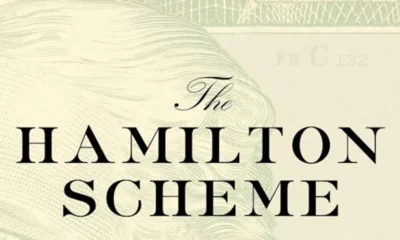Finance
Universal Economics: Necessary Reading for the Well-Trained Economist

- A Liberty Classics Book Review of Universal Economics, by Armen Alchian and William Allen.
What do you do when economists stop believing in economics? The “dismal science” never merited its dreary epithet, but trends in economics education at the graduate and undergraduate levels could change that. Ph.D. courses are saturated with hyper-mathematical models that are as sophisticated as they are irrelevant, as well as statistical pyrotechnics that amount to little more than brute description. Undergraduate courses trivialize the economic way of thinking and leave students incapable of intelligently discussing the complexity and richness of markets. Good economics is increasingly hard to find in the academy.
But there is hope. Finicky smartphones can be rebooted to their factory settings. We can do something similar with economics. There are plenty of resources for teachers and scholars who want to recapture the power and elegance of old-school price theory. Foremost among them is Armen Alchian and William Allen’s Universal Economics. This remarkable book teaches foundational economic concepts without reading like a textbook. Too often, course readings in economics come across like hastily assembled instructors’ manuals. Students find them sterile and enervating. But Universal Economics grips the reader and conveys the wonder of finding the hidden order in economic life. This book should be required reading for all Bachelors and Masters students, as well as a prerequisite for doctoral study.
As my colleague Bryan Cutsinger and I write in a forthcoming paper, price theory studies “how the price system coordinates the disparate plans of producers and consumers.” It is impossible to understand market economies without appreciating how the price system generates information and aligns incentives. This theme is consistent throughout Universal Economics. Alchian and Allen write from the perspective of the UCLA school of price theory, which emphasizes the importance of property rights and legal rules for shaping economic activity, as well as the surprising varieties of contractual devices producers and consumers use to overcome barriers to exchange.
Too many economists treat the economy as a machine, conveniently positioning themselves as the machinists whose tinkering makes the whole thing “work.” Alchian in Allen, in contrast, treat the economy as an object of inquiry, inviting the reader on a quest of joint discovery. Their goal is social comprehension, not social control. That enables them to avoid the common pitfalls of microeconomic analysis, such as equating price-taking behavior by firms with “perfect competition” or assuming margins of adjustment other than price indicate an economic inefficiency.
Universal Economics properly begins with the problem of scarcity, which makes necessary a system to determine who gets what. They immediately segue to rules and processes that can allocate resources. This puts property rights front and center. Queueing, discrimination, and violence are all schemes societies have used throughout history to allocate rights. What makes market economies unique is their reliance on “competitive cooperation by exchanges” to determine what gets produced, how it gets produced, and who gets the resulting products. Thinking about economic problems in terms of property rights helps us understand, for example, why politically free speech (“the right to communicate with your own resources to other willing listeners”) is never economically free. This is time well-spent: We cannot make good use of a market model, such as supply and demand, without understanding that market participants are exchanging rights to things, rather than things in themselves.
From their discussion of choice, cost, and trade, Alchian and Allen carefully build up the laws of demand. Chapter 6, titled “The Extent of Exchange,” is one of the book’s most valuable. Using a simple trade model, they demonstrate one of the most important yet least understood principles in basic economics: supply and demand are the same thing. Depending on the terms of trade (i.e., prices), the same household or firm can be a net demander or a net supplier of a commodity. We trade with each other until prices adjust such that everybody values the next additional unit of the commodity the same, in terms of foregone resources. “Equilibrium” is not merely an x-marks-the-spot point on a graph; it is the careful explication of the logic of exchange, driven by the purposes and values of the exchangers.
Universal Economics truly shines in its second part, which focuses on production and firms. Alchian and Allen distinguish between price takers and price searchers. They do not classify markets with price-taking firms as “perfectly competitive,” nor do they classify markets with price-searching firms as “imperfectly” or “monopolistically competitive.” Competition is not a function of how firms respond to market demand. It is something firms do, not something handed down on high in the form of an unalterable market structure.
The authors emphasize several important points that other books miss: Marginal costs increase with the rate of production, not the volume; profit maximization results from the filters and selection processes in markets, not the intentions or knowledge of managers; extraordinary profits cannot persist indefinitely, even without the entrance of new competitors, because markets will capitalize those profits into the value of the enterprise, raising average total cost. Furthermore, Alchian and Allen distinguish between profits earned in open competition versus profits secured through political lobbying and regulation. Rent-seeking can confer to firms a de facto property right to the market itself—something not included in the common-law commercial precedents they highlight early in the book.
My favorite chapters in this section focus on the theory of the firm and inter-firm dependencies. Why do firms exist in the first place? Why aren’t all producers independent contractors who spot-transact with consumers, with relative prices coordinating the whole process? Alchian and Allen defend the teamwork theory of the firm: Many production processes use team production, meaning the whole is greater than the sum of the parts. The parts (e.g., an individual employee’s contribution) are difficult to value, and hence difficult to compensate. This creates some bad incentives for team members. They would rather slack off and let other team members do the heavy lifting. But if every team member thinks this way, nothing gets produced, and nobody gets compensated. The firm, and in particular the manager, is a governance mechanism. The firm hierarchically polices production, ensuring team members contribute the right amount of effort to the group project.
Dependencies exist whenever two parties to a transaction—for example, one firm selling another firm an input into the latter’s production process—become sensitive to each other’s strategies. Repeat dealings and reputational capital can make continued business more attractive than switching to the market’s next best trading partner. This creates incentives for each party to cheat. Each firm might renege on previous agreements to extract some of the extra benefits both firms enjoy due to their specialized dealings. Many fascinating contractual practices arise to solve dependency problems between firms, or between firms and customers. Airlines can merge to avoid the problem of overcharging on split or shared routes; non-compete clauses give firms an incentive to invest in their employees, because employees cannot take their firm-financed human capital to a competing enterprise; publishers of newspapers print a price on the front page to make it costly for sellers and distributors of newspapers to reduce circulation by charging too much. Other textbooks, if they discuss these practices at all, declare them “anti-competitive” or use them as examples of “market failure.” Nonsense! Alchian and Allen take great care to show the reader this is what “cooperative competition” in the market looks like.
Alchian and Allen conclude their discussion of firm production by covering corporations and the stock market. They praise the corporation as “one of the great inventions during at least the past five centuries. It’s the dominant method of organizing and financing durable teams of people and resources for increased production of marketable goods—real income and wealth.” Notably, they explain the differences between firm liability structures (unlimited-liability partnerships vs. limited-liability corporations). As for the stock market, it “provides quick, low-cost salability of shares” for resale, as opposed to origination. The subsection on residual claimancy is particularly important. Any study of contemporary market economies will be incomplete unless it addresses the information-generating and incentive-aligning features of a property right to revenues in excess of costs, as the authors do.
Universal Economics does a very good job of integrating topics that are normally reserved for introductory business courses (balance sheets, earnings statements, etc.) and showing their relevance for coordinating the economic system. The chapter on the market for corporate control is especially helpful. Alchian and Allen explain an apparent puzzle of corporate governance: the separation of ownership and control. If property rights and incentives are so important, why would anyone sever these functions? The key is specialization. Especially for large, complex enterprises, those with a comparative advantage at running the firm are rarely the same as those with a comparative advantage in owning the firm (bearing risk). Upper management polices lower management, the chief corporate officers police upper management, and the board of directors police the chief corporate officers. The board themselves, as representatives of the shareholders, are accountable to the market—and if they fail in their oversight duties, “takeovers, tender offers, and leveraged buyouts are means of almost complete displacement” that can restore lost profitability.
Part three of Universal Economics is a crash course on wealth, interest rates, and financial markets. Students often need basic instruction in personal finance (how to budget; how compound interest works, etc.) and chapters 30-37 more than satisfy. Students will learn about optimal resource allocation over time, the determinants of capital prices, risk and insurance, competition and equalization of rates of return, and options trading. It is useful material, although probably this portion of the book is the least distinct from other books on similar topics.
“A well-trained price theorist, even if he cannot say everything about something, can say something about everything.”
UCLA price theory shines in the final part of the book. Alchian and Allen tackle topics usually reserved to macroeconomics courses: unemployment and inflation. They refuse to sunder economics by declaring certain topics off-limits. A well-trained price theorist, even if he cannot say everything about something, can say something about everything. For example, their discussion of unemployment—workers who want a job but don’t currently have one—incorporates information and search costs. The best job is rarely the first one to come along. Importantly, temporarily specializing in job search “can be productive, and in an important sense you are employed in wealth-maximizing activity, but the statisticians will count you as unemployed.” They extend this analysis to capital equipment not currently in use (idle resources). The analysis is a notable rebuke to narratives that rely on excessive aggregation, and hence are price-atheoretic, which unfortunately prevail among economists too busy making policy recommendations to think carefully about labor markets.
Universal Economics concludes with a chapter on money, prices, and inflation. It is a treat. Alchian and Allen remind the reader of the information-generating role of the price system. In a market economy, prices reflect opportunity costs. Price changes signal that the highest-valued use of resources has changed. To maximize wealth, the economic system must adapt accordingly—and thanks to property rights, prices, and profits, it does.
Yet this process depends on accurate perception of relative price changes, as dictated by alterations in the basic conditions (resource availability, technology, political and legal institutions, etc.) that underpin supply and demand. Since market prices are denominated in money, a well-functioning price system presupposes a well-functioning monetary system. What happens when, instead of monetary order, we have monetary disorder? As Alchian and Allen note, “When the standard of value—money—does not mean the same thing over time, we say there is noise or static in the pricing of goods and services. This static means the signals that are coming to decision makers from observed price changes cannot be relied upon to indicate that the use of productive resources is shifting.”
Policy-induced inflation or deflation, especially when unanticipated, throws a wrench in the economy’s gears. There is a signal-extraction problem when money’s purchasing power fluctuates: consumers and producers cannot be certain which price changes are due to nominal and which due to real factors. (Of course, any observed price change could be some combination of both.) Hence, “The amount of wealth there is available to consume by an economy will be affected by an inflationary process because of the effects on relative prices. Less well recognized, the distribution of income in the economy also will be altered.” The predictable result is allocation errors and the transfer of wealth between creditors and debtors. Market participants will take steps to minimize the costs of these problems. But those resources could be put to other productive uses if the monetary system were stable.
There is one final point I want to make about Universal Economics that underscores its value. Alchian and Allen never set up a “perfect” market as a standard against which real-world markets are judged and found wanting. They often employ thought experiments involving frictionless markets to ascertain why particular institutions or practices exist. But nowhere do you find the facile, efficiency-engineering approach that, even at introductory levels, permeates economics curricula. Economists are most definitely not plumbers according to Alchian and Allen.
To cite just one example from early in the book, after the authors introduce market-clearing prices, they immediately discuss why such prices frequently do not prevail. Bids and asks often diverge because of transaction costs: impediments to exchange that render the hypothetical equimarginal allocation (everyone values the next additional unit of the traded resource the same) too expensive to achieve. But rather than regard this as an imperfection or failure, they immediately proceed to discuss the important role of middlemen. These specialist intermediaries have a comparative advantage at linking up buyers and sellers. Supermarkets, banks, stockbrokers—all exist and perform a useful function because of transaction costs. Middlemen earn profits because they solve a real economic problem. Markets work because of, not in spite of, their frictions. Alchian was famous for insisting upon studying “economic forces at work,” so it is not surprising (but most welcome nonetheless!) to watch him subordinate the blackboard to the real world.
Universal Economics deserves to be read carefully by all students and practitioners of social science. Even those with advanced economics degrees—perhaps I should say “especially,” given the unfortunate state of graduate education—can benefit from selective rereading throughout their careers. I believe this book should be standard reading material in introductory economics courses. Depending on the program, it could also be used at the intermediate microeconomics level, as well as in master’s programs in public policy or philosophy, politics, and economics (PPE). Doctoral study in economics necessarily involves greater use of mathematics and statistics than in Universal Economics, but these tools must be used to deepen Alchian and Allen’s insights, not to avoid them.













